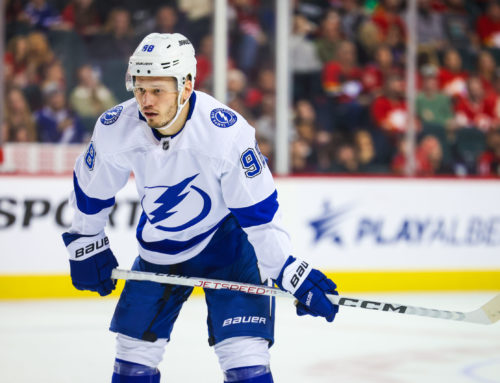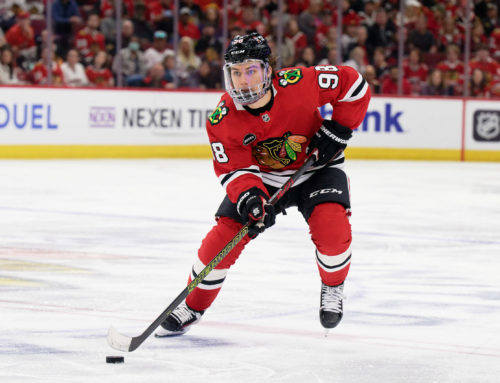Wild West: Playoff Heroes Becoming Fantasy Breakouts
Chris Kane
2018-06-04

Now that we have wrapped up our high performers for the year, I wanted to revisit a bit of playoff hockey. By next week we should be able to check in on all of the player and team predictions from the beginning of the playoffs, but for this week I wanted to follow up on some of Rick Roos’s work on Playoff Heroes. Definitely check out the article, it is an interesting read. In summary Rick found players over the last eleven seasons (this was last year – so did not include data from 2017-18) who had a breakout during the playoffs. His criteria for a breakout was that they had to have never scored 50 points in a full season but had scored at a .75+ (61+ full season) point pace over the playoffs. He also required at least ten playoff games to count a players’ stats to try and avoid incredibly small sample sizes. The rest of the article was devoted to determining if those playoff performances indicated anything about those players future performance. For the conclusions you will have to go read it. I wanted to look at something different though, is it possible we might be able to predict these heroes?
(This article started out looking at Western Conference players specifically, but just got too interesting so includes league data as well. Don’t worry next week will be back to just the West)
The table below shows Rick’s identified players from 2014-2017, plus those potential players from this year (I included Tom Wilson as he is right on the edge with games left to play) The job was then to go through all of these players and see if we could find any similarities between them that could help us figure out what type of player or season might predict the next unlikely playoff hero.
|
2018 |
|
|
2018 |
|
|
2018 |
|
|
2018 |
|
|
2017 |
|
|
2017 |
|
|
2016 |
|
|
2016 |
|
|
2016 |
|
|
2016 |
|
|
2016 |
|
|
2015 |
|
|
2014
📢 advertisement:
|
|
|
2014 |
|
|
2014 |
** Note For this next section the comparisons are between regular season and playoff numbers for an individual in the same year. All data collected comes from Dobber’s Frozen Tools and is as of Game 2 of the Stanley Cup Finals.***
During analysis I ended up taking out Jake Guentzel’s 2016-17 data and Jonathan Drouin’s 2015-16 data as they had played significantly fewer games during the season than the others, and that coupled with a few of their other stats made them significant outliers. That left us with a sample size of thirteen.
For the rest, it turns out there are remarkable consistencies. As should be fairly obvious all players increased their point-per-game numbers in the playoffs. Our selection criteria ensures this was true. The range was fairly wide, from players increasing by .2 points per game all the way up to 1.16. In average the players increased their point per game output by .38 points per game (about 30 points if carried out over a full season). Unsurprisingly, given that all players increased their scoring, all of the players also saw an increase in their points per 60 minutes played.
The third data point that all thirteen players had in common, which essentially explains much of the other data is an increase in time on ice. Many of the players saw upwards of a two-minute increase in time on ice per game. The combined average of season time on ice was about 15:50 per game and rose to 17:40 during the playoffs.
In addition, nine of the thirteen players saw an increase in their power play time (an average increase from 1:33 to 2:04) and a correlated increase in power play points per game. Similarly, nine players saw an increase in shots per game (though not necessarily the same players as saw the increase in power play time and points) and twelve of the thirteen saw an increase in their shooting percentage.
The other major stat of note is IPP (the percentage of goals a player gets a point on that are scored while they are on the ice). Eleven of the thirteen players saw an increase in their IPP while all thirteen either managed to keep in the same or saw growth.
The data seem to imply that players are increasing their point production because they are given a larger role. More time on ice leads to more shots, more points, and higher points per game. More power play time leads to more power play points, better opportunities so a potential increase in shooting percentage and IPP. The small sample size can also keep things like a high shooting percentage and IPP inflated.
(Side Bar: The one category that did not increase on average across the players, in fact saw a slight decrease, was the percentage of starts in the offensive zone. Nine of the thirteen players saw a decrease in this area and on average the above players were seeing about 4.5% fewer offensive zone face off starts in the playoffs than in the regular season.)
Where did this ice time come from? Are we seeing players fill in for an injury? Have they been suddenly promoted to a new line? Those might be logical guesses, but it doesn’t necessarily seem to be the case. Of the thirteen players five seem to have been playing the majority of their even strength shifts with different line mates, but only in three cases was it a definite improvement (that means about 25% of the players saw better linemates at even strength). The story is slightly different on the power play, where eight of the thirteen cases saw a change in line mates, and five were definite improvements (38%). Overall though the majority of players are seeing more time, but not necessarily with different or better players. I don’t have a specific answer for this question of increased ice time, perhaps second and third lines see an increase in time at the expense of the fourth line, or they are matched to other lines more often, or perhaps in some cases there is just more time to be had as there are overtime periods in playoffs. That might be research for another day.
Ok but does this help us? What do we know about these players that could enable us pick out a future unlikely playoff hero. The most important and possibly obvious similarities with these players is that they are showing some ability to perform during the season – but have the room to improve with increased time on ice. A player who is already scoring at a point-per-game clip, getting 20 minutes per game, or is getting ton of time on the power play isn’t going to be your unlikely playoff hero, they are being counted on already to contribute in a big way.
So what was the prototypical unlikely playoff hero profile from 2014-18? An unlikely playoff hero, according to the above data, should have played 60+ games in the regular season (though Drouin and Guentzel show us that is might not always be required). The player should be averaging between .4 and .7 points per game, should be shooting around two shots a game, with a least a shoot percentage of 9%, be getting somewhere between 1:00 and 2:15 minutes on the power play, and skating between 13:00 and 17:00 minutes of total time on ice. The data points can fluctuate slightly depending on situation, and players might miss one by a little, but this is the general target. Perhaps the single most important factor though is that they play for a team that is likely to get about 17 games during the playoffs.
For the 2017-18 playoffs, who met that specific criteria? There were 35 players on playoff teams who met the above stat lines, but we need to sort for playoff success. In order to play 17 playoff games, the team has to reach the conference final, and potentially the Stanley Cup final itself. Based on the Expert Panel Predictions, Winnipeg, Nashville, Boston, Tampa Bay and Pittsburgh were the most frequent picks to make it to the Cup final. There were thirteen players on those five teams who met the above criteria. Unfortunately the majority of those teams did not perform up to expectations and left us with only four (31%) players who passed the .7 points per game threshold, let alone .75: Jake Guentzel, Ondrej Palat, Paul Stastny, and Patric Hornqvist. Two of them, Stastny and Hornqvist are only borderline unlikely as they have had more successful seasons in the past, though met the criteria for this year.
If we assume access to a Magic 8 Ball or that we had guessed the final four correctly we are left with ten names and again four (40%) of them are over .7 points per game: Ondrej Palat, Paul Stastny, Tom Wilson, and Lars Eller. Those that have missed the mark thus far are: Tomas Tatar, Alex Tuch, Bryan Little, Alex Killorn, Tyler Johnson, and James Neal. Tuch and Neal at least still have time to improve.
If we were to look at it in a slightly different way, of the seven players we could have potentially considered an unlikely playoff hero this year with small caveats (Tomas Hertl, Ondrej Palat, Paul Stastny, Tom Wilson, Lars Eller, Jake Guentzel and Patric Hornqvist) four were on our Magic 8 Ball list, and two that were missing were Penguins on the previous list. The only remaining player (Hertl) did meet all of the player criteria, so was on our original list of 35, but as San Jose did not make most people’s cut to be a conference final team he did not make any of the lists.
So how did we do? Well, all seven of the potential unlikely playoff heroes were on the original list of 35. That is good, but does highlight how important is it to pick the right team. We had a 40% shot of drafting an unlikely playoff hero if picked the right final four teams, a 31% chance to pick based on the Expert Guide’s finals picks, and a 20% chance considering all of the playoff teams. As a quick reference if you randomly selected a second or third line player from a playoff team you had a 7% chance of grabbing an unlikely playoff hero. So while chances still aren’t fantastic, using the Expert Guide gave us an increase of 24% and that seems like a solid improvement.
Thanks for reading.
Next week: West Coast Playoff Wrap Up
My immediate thought was that the sample size was likely so small that the growth could probably be accounted for with random chance. For comparison I took a look at the first month and a half of each of the last three seasons to find out how many players were at that .75 point per game threshold. What I found surprised me. Between 80-90% of the players who were scoring at least a point per game 17 games into the season were also scoring at that rate by the end of the year. Granted we are talking about a different, less productive subset of players here as they can’t have scored a 50-point season yet to be on this list, but perhaps the sample size isn’t as big a factor as I had assumed.





 BUF
BUF N.J
N.J PHI
PHI MIN
MIN VAN
VAN FLA
FLA TOR
TOR CGY
CGY CHI
CHI